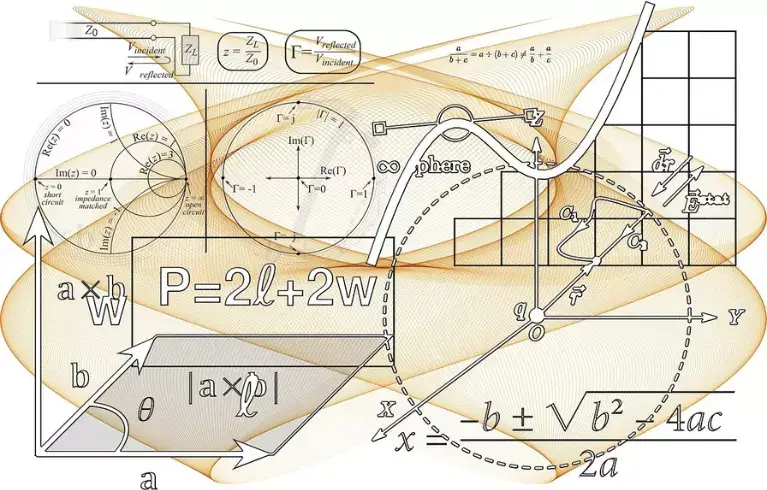Real numbers are the backbone of mathematics, spanning a wide range of values along the number line. They’re like the superheroes of numbers, including familiar integers, fractions, and decimals, both rational and irrational. But did you know that the properties of real numbers are actually used in real life? That’s right, these numbers represent quantities, distances, and magnitudes in the real world, making them an essential concept in mathematics. From simple addition and subtraction to complex calculus, these versatile numbers are the key to unlocking the mysteries of our universe’s quantitative aspects. So, if you want to be a math whiz, start by mastering the power of real numbers!
Integers
Hey there! If you’re a math whiz, you probably already know about counting numbers. But just in case you need a refresher, let’s talk about integers. Integers are whole numbers – that means they can be positive, negative, or even zero! We use the symbol $\mathbb{Z}$ to represent the set of all integers.
Now, let’s move on to whole numbers. These are non-negative integers, which means they can’t be negative but they can be zero. We use the symbol $\mathbb{N}$ to represent the set of all whole numbers.
Last but not least, let’s talk about natural numbers. These are positive integers, which means they can’t be zero but they can be any positive number. We use the symbol $\mathbb{N}^\ast$ to represent the set of all natural numbers.
So there you have it – a quick rundown of counting numbers, integers, whole numbers, and natural numbers. Happy counting!
What is a real number?
Real numbers are the backbone of mathematics, representing positions along the number line and encompassing a vast range of values. They come in two main categories: rational and irrational numbers. Rational numbers are those that can be expressed as a fraction of two integers, including integers, fractions, and repeating or terminating decimals: $$ \mathbb{Q}=\left\{\frac{p}{q}: p,q\in\mathbb{Z},\;q\neq 0\right\}.$$ On the other hand, irrational numbers are those that cannot be expressed as a simple fraction and have non-repeating, non-terminating decimal expansions. We use the symbol $\mathbb{Q}^c$ to represent the set of all irrational numbers. With this notation, the set of real numbers is $$ \mathbb{R}=\mathbb{Q}\cup \mathbb{Q}^c.$$
Finally, non-negative real numbers include all real numbers greater than or equal to zero, including positive real numbers, zero, and all non-positive real numbers.
Real numbers are used extensively in mathematics to represent quantities, measurements, and values in various scientific disciplines. They are a fundamental concept in mathematical analysis and are essential for understanding the world around us. So, whether you’re a math whiz or just starting to explore the world of numbers, real numbers are a crucial concept to grasp.
Properties of real numbers
In this paragraph, we list some important properties of real numbers.
Closure property :
Did you know that real numbers have a superpower? They possess the closure property, which means that when you add or multiply two real numbers, the result will always be another real number. It’s like they have a secret code that keeps them together, making them closed under addition and multiplication. Pretty cool, right? If $a$ and $b$ are real numbers, the $a+b$ and $ab$ are also real numbers,<
Commutative Property :
The commutative property is a fundamental concept in mathematics that pertains to the addition and multiplication of real numbers. Specifically, it denotes that the order in which numbers are arranged does not impact the outcome of these operations. In the case of addition, the commutative property is expressed as $a + b = b + a$, while for multiplication, it is represented as $a b = b a$.
Associative Property:
The Associative Property pertains to the operations of addition and multiplication of real numbers, whereby the grouping of numbers does not alter the outcome. Specifically, in the case of addition, the expression $(a + b) + c$ is equivalent to $a + (b + c)$, while in the case of multiplication, $(a b)c$ is equivalent to $a (b c)$.
Identity Property:
The identity element for addition is denoted as $0$, as it satisfies the condition that the sum of any real number $a$ and $0$ is equal to $a$. Similarly, the identity element for multiplication is represented by the number $1$, as it satisfies the condition that the product of any real number $a$ and $1$ is equal to $a$. This property is essential in various mathematical applications and serves as a basis for further mathematical operations.
Inverse Property:
For any real number $a$, there exists an additive inverse, denoted as $(-a)$, such that the sum of $a$ and its additive inverse is equal to zero, i.e., $a + (-a) = 0$. Furthermore, for any nonzero real number $a$, there exists a multiplicative inverse, denoted as $\frac{1}{a}$, such that the product of $a$ and its reciprocal is equal to one, i.e., $a \times \frac{1}{a} = 1$. This property is of great significance in various mathematical fields, including algebra, calculus, and number theory.
Distributive Property
The distributive property is a fundamental mathematical principle that asserts that multiplication is distributive over addition. Specifically, it states that the product of a given number, denoted by “$a$,” and the sum of two other numbers, denoted by “$b$” and “$c$,” is equivalent to the sum of the products of “$a$” and each of the two numbers, “$b$” and “$c$.” This can be expressed mathematically as $a \times (b + c) = (a \times b) + (a \times c)$.
Transitive Property
The Transitive Property is a fundamental principle in mathematics that states that if two quantities, $a$ and $b$, are equal, and $b$ and $c$ are also equal, then $a$ and $c$ must be equal as well. This property plays a crucial role in establishing equalities and inequalities involving real numbers, and is widely employed in various mathematical disciplines.
Ordering Property
The concept of ordering property pertains to the arrangement of real numbers in ascending or descending order. Specifically, if a real number $a$ is less than another real number $b$, it is denoted as $a < b$. Conversely, if $a$ is greater than $b$, it is represented as $a > b$. The concept of ordering property pertains to the arrangement of real numbers in ascending or descending order. Specifically, if a real number a is less than another real number b, it is denoted as a < b. Conversely, if a is greater than b, it is represented as a > b.
Density Property
The Density Property is a fundamental characteristic of the real number line, which asserts that an infinite number of real numbers exist between any two given real numbers. This property underscores the continuity of the real number line. Specifically, for any two real numbers $a$ and $b$ such that $a < b$, there exists at least one rational number $r$ that satisfies the inequality $a < r < b$.
The aforementioned properties serve as the fundamental basis for resolving equations, inequalities, and diverse mathematical operations that entail real numbers. Their significance in the fields of algebra and calculus is paramount, as they facilitate the comprehension and manipulation of real-world quantities and data by mathematicians and scientists.
What is the Absolute Value of a Real Number?
The absolute value of a real number, represented by the symbol |x| and pronounced as “the absolute value of x,” is a metric that quantifies the distance between the number and zero on the number line. This metric provides a measure of the magnitude of a number, irrespective of its sign. The absolute value is always a non-negative real number or zero. The definition of the absolute value is as follows:
- For a positive real number x, the absolute value is equivalent to the number itself: $|x| = x$.
- For a negative real number x, the absolute value is the additive inverse of that number: $|x| = -x$.
- For zero, the absolute value remains zero: $|0| = 0$.
We recall the following triangular inequality: for all real numbers $x$ and $y$, $$ |x+y|\le |x|+|y|.$$
The utilization of the following noteworthy identities is deemed advantageous:
\begin{align*} &(a+b)^2=a^2+2ab+b^2\cr & (a-b)^2=a^2-2ab+b^2\cr & (a+b)(a-b)=a^a-b^2\cr & (a+b)^n=\sum_{k=0}^n \binom{n}{k} a^kb^{n-k},\end{align*} where $$ \binom{n}{k}=\frac{n!}{k!(n-k)!},\quad n!=1\times 2\times 3\times\cdots\times n.$$
These identities play a vital role in mathematics. The first two aid in expanding quadratic expressions, while the third facilitates the factorization of the difference between two squares. The fourth identity, known as the binomial theorem, allows for the expansion of binomial expressions raised to positive integer powers. In the fourth identity, the summation notation signifies that it involves a sum of terms. Each term results from the multiplication of a binomial coefficient by the product of the appropriate powers of the two terms in the binomial expression.
What is an integer part of a real number?
The “floor” of a real number, commonly known as its integer part, is defined as the largest integer that is less than or equal to the given real number. This operation effectively truncates the decimal portion of the number, leaving only the integer component. The notation used to denote the integer part of a real number x is commonly represented as $[x]$. The integer part of a real number satisfies the following important property
For all real number, $$ [x]\le x < [x]+1.$$
For instance, if we consider the real number $5.7$, its integer part is $[5.7] = 5$, since the largest integer that is less than or equal to $5.7$ is $5$. Similarly, for the real number $-3.2$, its integer part is $[-3.2]= -4$, as the largest integer that is less than or equal to $-3.2$ is $-4$. In the case of $8.0$, since there is no decimal component, its integer part is $[8.0]= 8$. Finally, for the irrational number $\pi,$ approximately $3.14159$, its integer part is $[\pi] = 3$, as the largest integer that is less than or equal to $\pi$ is $3$.
Frequently Asked Questions on Real Numbers
| What Are Real Numbers? |
+ |
| Real numbers are a set of numbers that includes all rational and irrational numbers. They can be represented on the number line and encompass a wide range of values, including integers, fractions, decimals, and more. |
| What Are Rational Numbers? |
+ |
| Rational numbers are real numbers that can be expressed as fractions, where the numerator and denominator are integers, and the denominator is not zero. Examples include 1/2, -3/4, and 7. |
| What Are Irrational Numbers? |
+ |
| Irrational numbers are real numbers that cannot be expressed as fractions and have non-repeating, non-terminating decimal expansions. Examples include $\sqrt{2} and $\pi$. |
| What Is the Absolute Value of a Real Number? |
+ |
| The absolute value of a real number, denoted as $|x|$, represents the distance of that number from zero on the number line. It is always a non-negative value. For example, $|5|=5$ and $|-5|=5$. |
| What Are the Properties of Real Numbers? |
+ |
| Real numbers are like a treasure trove of mathematical properties! They’re closed, meaning that when you add or multiply them, you always end up with another real number. Plus, they’re super friendly – addition and multiplication are commutative and associative, so you can rearrange and group them however you like. And let’s not forget about their trusty sidekicks, the identity elements – 0 for addition and 1 for multiplication. But wait, there’s more! Real numbers also have inverse elements, which means that for every number, there’s a special friend that, when added or multiplied together, gives you the identity element. And finally, the cherry on top – the distributive property, which lets you distribute multiplication over addition “or vice versa” like a boss. Who knew numbers could be so cool? |











